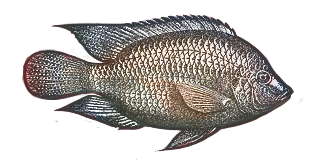Tilapia
A mild white fish, tilapia is available year-round. It's
available whole, fresh, frozen, or even live in some Asian
restaurants. It can also be found as fresh or frozen fillets.
Tilapia is known as izumidai when prepared for sushi.
Tilapia is a fast-growing tropical species, native to Africa,
but produced in more than 100 nations - surpassing any
other farmed fish. It is the fourth most-consumed seafood
in the United States after shrimp, tuna and salmon.
China,
the world's largest producer of farmed tilapia, supplies approximately 40% of global production. Nearly 40% of
this is exported to the U.S., mainly as frozen fillets.
Tilapia can be farmed in either fresh or salt water.
Most Chinese tilapia is farmed in ponds.
Recent reductions in water use, achieved by only emptying
the ponds at the time of each harvest, has also reduced
discharge of effluent to the environment. Both of these
factors were sufficient to raise this recommendation
from its previous "Avoid" to a "Good Alternative."
WRGS (whole round gutted and scaled)
– 350/550 gram, 550/750 gram, 750 gram/up
Tenders (IQF or vacuum packed)
Loins (IQF or vacuum packed)
Portions (IQF or vacuum packed)
Fillets (IQF or vacuum packed)
Chang Versions Offered
Tilapia fish are often called "St. Peter's fish" due to the fact
that the fish that Peter caught and that carried a shekel coin
in its mouth described in Matthew 17:24-27 was a Tilapia!!
Tilapia are used in many ethnic cultures in these days of
global trading, and fair well when prepared by steaming,
broiling, frying, roasting, pan frying, flat top grilling, BBQ
grilling, stir-frying, blackened in a smoking hot cast iron
skillet, or chunking and in your favorite saute recipe.
Tilapia is low in saturated fat, and are an excellent
source of selenium, phosphorus and Vitamin D.









